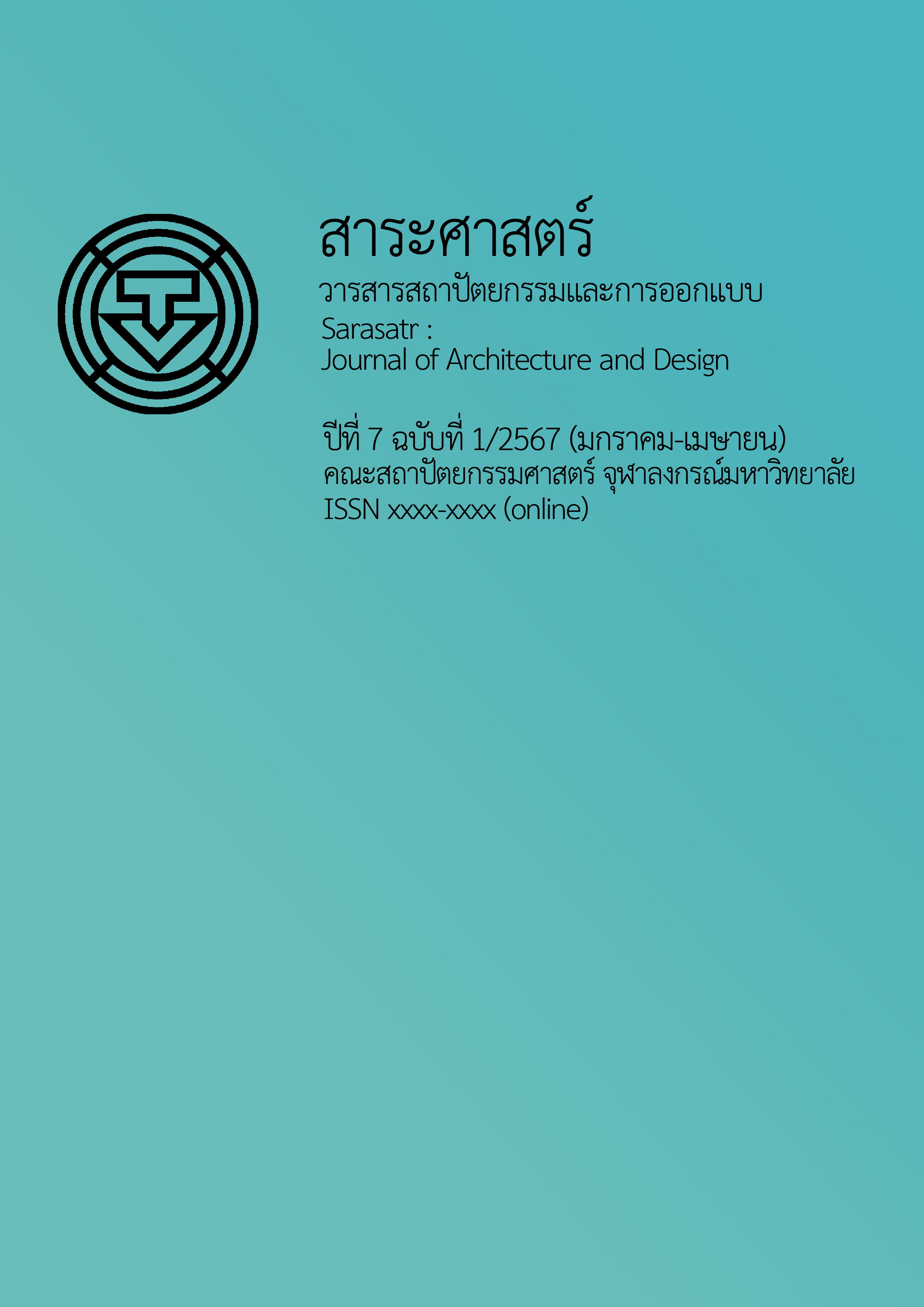Ruen Thai: A Comparative Study between Thai Traditional House and Villa Savoye
Main Article Content
Abstract
Traditional Thai houses were discovered in the 13th B.E. petroglyphs and were documented in the memorandum of Simon de La Loubère, also known as ‘Du Royaume de Siam’ in French. Simon de La Loubère was a French ambassador during the Ayutthaya era. In his book, he described a traditional Thai house as a house standing on the high columns, leaving a vacant space underneath, with a high-pitched roof and straightforward construction. On the other side of the world, 200 years later, stands a house called “Villa Savoye”, designed by Le Corbusier, a Swiss-French architect. His manifesto, ‘Five points of Architecture’ laid the foundation for the Modern architecture movement. The manifesto encompasses ‘pilotis, free plan, free facade, ribbon window, and roof garden’. Interestingly, both houses share some similarities. Therefore, this research aims to explore the similarities and differences between the two houses. The author reviewed documents from multiple sources about Traditional Thai houses, Villa Savoye, Le Corbusier, and the Five points of Architecture manifesto and compared them. The study demonstrate that a traditional Thai house and Villa Savoye share certain similarities in alignment with the manifesto. Pilotis, free plan, and free facade are among their shared similarities, although they differ in terms of concepts, appearance, material, and methods. Ribbon window and roof garden are not found in a tradition Thai house. Additionally, the research has discovered that both buildings feature extensive roofless terraces, zonings, and accessibilities in a comparable manner. Contrastingly, the construction methods are different.
Article Details
References
กรกฎา. (2019). Modern movement จุดกำเนิดสถาปัตยกรรมสมัยใหม่. บ้านและสวน. https://www.baanlaesuan.com/143638/design/modern-movement
กรมศิลปากร. สำนักสถาปัตยกรรม. (2554). โครงสร้างสถาปัตยกรรมไทยประเภทเครื่องไม้ : เรือนไทยภาคกลาง. สำนัก.
ต้นข้าว ปาณินท์. (2559). อดอลฟ์ โลส บทสนทนากับความว่างเปล่า. ลายเส้น.
น. ณ ปากน้ำ. (2555). แบบแผนบ้านเรือนในสยาม (พิมพ์ครั้งที่ 6). ด่านสุทธาการพิมพ์.
นราธิปประพันธ์พงศ์, พระเจ้าบรมวงศ์เธอกรมพระ. (2505). จดหมายเหตุลาร์ลูแบร์ เล่ม 1. ศึกษาภัณฑ์พาณิชย์.
ภัทรา เชาว์ปรัชญากุล. (2563). ชวนมารู้จักชาวนาไทย ตอนที่ 5 "วิถีชีวิตบ้านบ้าน : เรือนไทยภาคกลาง องค์ประกอบของเรือนเครื่องสับ. กลุ่มเผยแพร่และประชาสัมพันธ์ กรมศิลปากร. https://www.finearts.go.th/promotion/view/16759-ชวนมารู้จักชาวนาไทย-ตอนที่-5--วิถีชีวิตบ้านบ้าน---เรือนไทยภาคกลาง-องค์ประกอบของเรือนเครื่องสับ-
ยุภาพร ธัญวิวัฒน์กุล. (2556). เรือนไทย ภูมิปัญญาแห่งสถาปัตยกรรม. อิ่มดี ครีเอชั่น.
ฤทัย ใจจงรัก. (2532). เรือนไทยภาคกลาง. สารานุกรมไทยสำหรับเยาวชน. https://www.saranukromthai.or.th/sub/book/book.php?book=13&chap=1&page=t13-1-infodetail02.html
ศราวุธ เปรมใจ. (2562). สู่แก่นแท้ของสถาปัตยกรรม : เลอ กอร์บูซีเย. อมรินทร์.
ศรีศักร วัลลิโภดม. (2552). เรือนไทย บ้านไทย. สำนักพิมพ์เมืองโบราณ.
ศูนย์มานุษยวิทยาสิรินธร (องค์กรมหาชน). (2023). อภิธานศัพท์. ฐานข้อมูลแหล่งโบราณคดีที่สำคัญในประเทศไทย. https://db.sac.or.th/archaeology/terminology/index?a=ฝ
สมใจ นิ่มเล็ก. (2526). เรือนเครื่องผูก. หน้าจั่ว สถาปัตยกรรม การออกแบบ และสภาพแวดล้อม, (3), 247–268.
สันต์ ท. โกมลบุตร. (2554). จดหมายเหตุ ลา ลูแบร์ ราชอาณาจักรสยาม. สำนักพิมพ์ศรีปัญญา.
สำนักงานส่งเสริมศิลปวัฒนธรรมและล้านนาสร้างสรรค์. (2023). เรือนฝาไหลของแม่คำเที่ยง. พิพิธภัณฑ์เรือนโบราณล้านนา. https://art-culture.cmu.ac.th/Museum/detail/13/#:~:text=เรือนหลังนี้เดิมเป็น, ชั้นบนใช้เป็นที่พัก
ArchEyes. (2024). Villa Savoye by Le Corbusier: A masterpiece of modern architecture. https://archeyes.com/the-villa-savoye-le-corbusier/
The building: Villa Savoye-Le Corbusier. (n.d.). https://villasavoye.weebly.com/the-building.html
Choay, F. (2023, August 23). Le Corbusier, Swiss architect. Britannica. www.britannica.com/biography/Le-Corbusier
Le Corbusier’s five points of architecture. (2023). Wikipedia.https://en.wikipedia.org/wiki/Le_Corbusier%27s_Five_Points_of_Architecture
Le Corbusier’s Villa Savoye. (n.d.). Archi-Monarch.com. https://archi-monarch.com/le-corbusiers-villa-savoye/
Frampton, K. (1972). Displacement of concepts in Le Corbusier. In Architectural design (Vol. 43, pp. 51–52). MIT Press.
Gans. (n.d.). The plan for the town of St-Die and the Duval factory. Saint-Dié-Des-Vosges and Le Corbusier. http://usine.duval.free.fr/english.htm
Louw, M. (2016). The architecture promenade and the perception of time. South African Journal of Art History, 31(2), 12-33. https://www.researchgate.net/publication/342657325_The_architectural_promenade_and_the_perception_of_time
Mehmeti, L. (2014). Architecture analysis of Le Corbusier’s Villa Savoye [Unpublished graduate thesis]. University for Business and Technology in Kosovo.
Moreira, S. (2020). The 5 points of modern architecture in contemporary projects. Arch Daily. https://www.archdaily.com/948273/the-5-points-of-modern-architecture-in-contemporary-projects
Rehman, R. (2021). Le Corbusier – The father of modern architecture. Cubic Feet Design. https://www.thecubicfeetdesign.com/blog/le-corbusier-the-father-of-modern-architecture/#:~:text=Le%20Corbusier%20is%20known%20as,a%20French%20citizen%20in%201930
Villa Savoye, what it is like to live in “the box in the air.” (2022, June 15). Travel Carpet. https://talkcarpet.com/villa-savoye-what-it-is-like-to-live-in-the-box-in-the-air/


